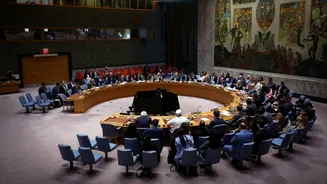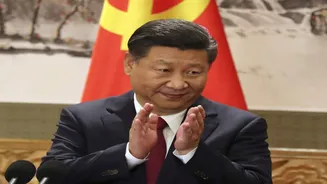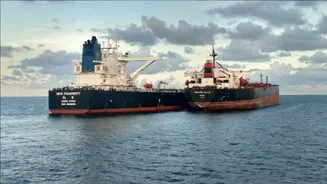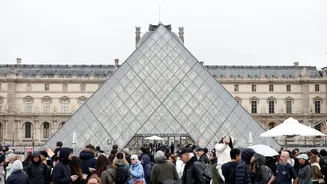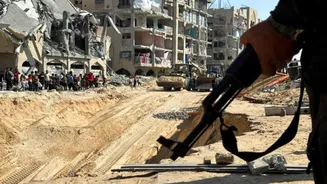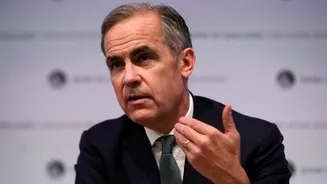Decades later, the date would also see Concorde’s final commercial flight in 2003 — the end of an aviation marvel — while in 2012, Hurricane Sandy began its destructive path through the Caribbean.
In 1921, the Unknown Soldier was selected in the United States, a solemn act of remembrance for those lost to war.
We take a look at these events as part of Firstpost's History Today series.
The United Nations is established
In the aftermath of the Second World War, with tens of millions dead and cities across Europe and Asia reduced to rubble, the leaders of the Allied powers recognised the urgent need for a new international order — one that would prevent future global conflicts and encourage cooperation between nations.
This vision materialised on October 24, 1945, when the United Nations (UN) was officially established after the ratification of its Charter by the majority of signatory states, including the five permanent members of the Security Council — the United States, the United Kingdom, the Soviet Union, China, and France.
The UN’s creation was not a spontaneous event but the culmination of years of diplomatic groundwork.
The idea of an international body dedicated to maintaining peace had already taken root with the League of Nations, founded after World War I, but that institution’s inability to prevent global conflict had revealed its weaknesses.
Determined not to repeat those mistakes, world leaders began planning for a new structure even before the end of World War II.
The Atlantic Charter of 1941, signed by US President Franklin D Roosevelt and British Prime Minister Winston Churchill, outlined principles that would later guide the UN’s foundation — collective security, economic cooperation, and respect for human rights.
Between April and June 1945, representatives from 50 nations met in San Francisco for the United Nations Conference on International Organisation.
The result of their deliberations was the UN Charter, a comprehensive framework establishing the purposes, principles, and institutions of the new organisation.
The Charter was signed on June 26, 1945, and came into force four months later, on October 24, after the required number of nations had ratified it.
This date has since been celebrated as United Nations Day, a global observance marking the start of the world’s most enduring experiment in international governance.
The UN’s founding purpose was clear: “to save succeeding generations from the scourge of war.”
But beyond peacekeeping, the organisation was also tasked with promoting human rights, fostering social and economic development, and ensuring respect for international law.
Its structure was divided into several key organs, including the General Assembly, where all member states have equal representation; the Security Council, responsible for maintaining peace and security; the International Court of Justice; and the Economic and Social Council (ECOSOC).
In its early years, the UN played a vital role in mediating disputes and overseeing post-war reconstruction. One of its first challenges was the growing tension between the Soviet bloc and Western powers — tensions that soon evolved into the Cold War.
The Security Council, often paralysed by vetoes, struggled to address conflicts like the Korean War (1950-1953) and the Suez Crisis (1956).
Still, the UN became a crucial platform for dialogue, giving newly independent nations a voice during the decolonisation era of the 1950s and 1960s.
The organisation’s humanitarian work also grew rapidly. Agencies such as UNICEF (United Nations International Children’s Emergency Fund), WHO (World Health Organisation), UNESCO (United Nations Educational, Scientific and Cultural Organisation), and FAO (Food and Agriculture Organisation) emerged as key instruments of development and relief.
These institutions helped combat disease, promote education, and provide aid to war-torn and impoverished regions, reinforcing the UN’s moral authority even when political unity faltered.
As membership expanded — from the original 51 nations to 193 today — the UN evolved into the largest and most representative body in the world.
Its peacekeeping missions became a hallmark of its identity, with the first operation deployed in 1948 to monitor the ceasefire in West Asia following the Arab-Israeli conflict.
Over the decades, blue-helmeted peacekeepers would serve in regions from Africa to the Balkans, often under challenging and dangerous conditions.
Despite its achievements, the UN has faced persistent criticism for bureaucratic inefficiency, inconsistent enforcement of resolutions, and political bias within the Security Council.
The power of veto — held by its five permanent members — has frequently paralysed action on major crises, from the Syrian civil war to Russia’s invasion of Ukraine. Yet, even its harshest critics concede that the UN remains indispensable as a forum for diplomacy and coordination.
The UN has become central to addressing climate change through frameworks like the Paris Agreement, advancing gender equality via UN Women, and steering global development efforts through the Sustainable Development Goals (SDGs).
The UN’s motto of “We the Peoples” endures as both a vision and a challenge — a reminder that the world’s security and prosperity ultimately depend on cooperation, dialogue, and shared responsibility.
Concorde’s final commercial flight
On October 24, 2003, the era of supersonic passenger travel came to an end when the Concorde made its final commercial flight from New York to London’s Heathrow Airport.
Developed jointly by Britain and France in the 1960s, the Concorde was an icon of aviation — capable of cruising at twice the speed of sound (Mach 2) and cutting transatlantic flight times to just over three hours.
However, despite its engineering brilliance, the Concorde faced economic and environmental hurdles. High fuel costs, limited passenger capacity, and noise restrictions made operations unprofitable.
The tragic crash of Air France Flight 4590 in 2000 further accelerated its retirement.
When Concorde touched down for the last time in 2003, it marked the close of an age when speed and style defined commercial air travel.
Hurricane Sandy strikes Jamaica
On October 24, 2012, Hurricane Sandy was officially classified as a hurricane as it intensified near Kingston, Jamaica. What began as a tropical depression in the Caribbean quickly evolved into one of the most destructive storms in recent history.
Sandy tore through Jamaica and Cuba, later merging with a cold front to become a “superstorm” that devastated the US East Coast, especially New York and New Jersey.
Sandy caused an estimated $70 billion in damages and claimed more than 230 lives across eight countries.
It also triggered serious conversations about climate resilience, urban infrastructure, and the growing frequency of extreme weather events in a warming world.
The selection of the Unknown Soldier
In 1921, amid the lingering grief of World War I, the United States Army selected an unidentified American serviceman to represent all those who had died without recognition.
The soldier’s body was chosen on October 24 from among four unknowns exhumed from European battlefields.
His remains were later interred at Arlington National Cemetery in a ceremony attended by US President Warren G Harding.
The Tomb of the Unknown Soldier became a sacred national symbol of sacrifice and remembrance, honouring not only the unnamed dead of the Great War but all unidentified soldiers who gave their lives in service to their country.
With inputs from agencies
